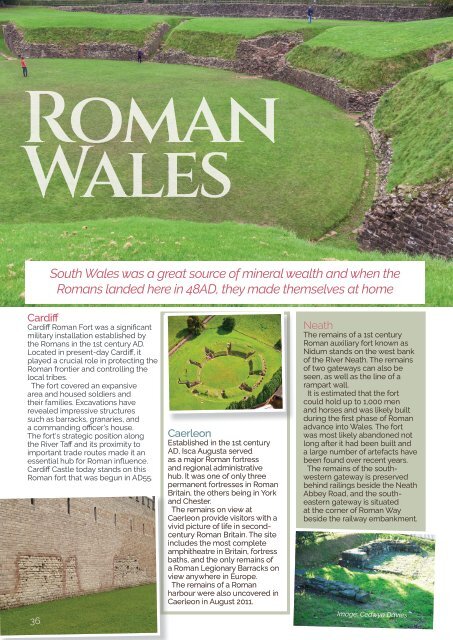Rhiwbina Living
Summer 2023 issue of Rhiwbina Living, the award-winning magazine for Rhiwbina.
Summer 2023 issue of Rhiwbina Living, the award-winning magazine for Rhiwbina.
- TAGS
- wales
- whitchurch
- rhiwbina
- cardiff
Create successful ePaper yourself
Turn your PDF publications into a flip-book with our unique Google optimized e-Paper software.
Roman<br />
Wales<br />
South Wales was a great source of mineral wealth and when the<br />
Romans landed here in 48AD, they made themselves at home<br />
Cardiff<br />
Cardiff Roman Fort was a significant<br />
military installation established by<br />
the Romans in the 1st century AD.<br />
Located in present-day Cardiff, it<br />
played a crucial role in protecting the<br />
Roman frontier and controlling the<br />
local tribes.<br />
The fort covered an expansive<br />
area and housed soldiers and<br />
their families. Excavations have<br />
revealed impressive structures<br />
such as barracks, granaries, and<br />
a commanding officer's house.<br />
The fort's strategic position along<br />
the River Taff and its proximity to<br />
important trade routes made it an<br />
essential hub for Roman influence.<br />
Cardiff Castle today stands on this<br />
Roman fort that was begun in AD55.<br />
36<br />
Caerleon<br />
Established in the 1st century<br />
AD, Isca Augusta served<br />
as a major Roman fortress<br />
and regional administrative<br />
hub. It was one of only three<br />
permanent fortresses in Roman<br />
Britain, the others being in York<br />
and Chester.<br />
The remains on view at<br />
Caerleon provide visitors with a<br />
vivid picture of life in secondcentury<br />
Roman Britain. The site<br />
includes the most complete<br />
amphitheatre in Britain, fortress<br />
baths, and the only remains of<br />
a Roman Legionary Barracks on<br />
view anywhere in Europe.<br />
The remains of a Roman<br />
harbour were also uncovered in<br />
Caerleon in August 2011.<br />
Neath<br />
The remains of a 1st century<br />
Roman auxiliary fort known as<br />
Nidum stands on the west bank<br />
of the River Neath. The remains<br />
of two gateways can also be<br />
seen, as well as the line of a<br />
rampart wall.<br />
It is estimated that the fort<br />
could hold up to 1,000 men<br />
and horses and was likely built<br />
during the first phase of Roman<br />
advance into Wales. The fort<br />
was most likely abandoned not<br />
long after it had been built and<br />
a large number of artefacts have<br />
been found over recent years.<br />
The remains of the southwestern<br />
gateway is preserved<br />
behind railings beside the Neath<br />
Abbey Road, and the southeastern<br />
gateway is situated<br />
at the corner of Roman Way<br />
beside the railway embankment.<br />
Image: Cedwyn Davies

















